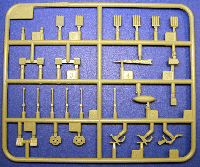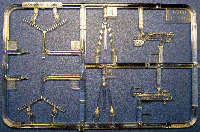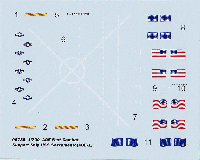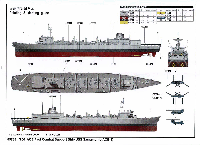| HISTORY |
|
|
The four ships of the Sacramento class of fast support ships were the largest of their kind ever built. These vessels carried a variety of goods, supplanting the need for oilers (AO'), ammunition ships (AE), and stores and cargo ships (AF and AK). The Sacramento class was designed with operations with a carrier battle group in mind, with four refuelling stations to port and two to starboard, combined witn three dry-goods transfer stations to port and four to starboard. This class was an early adopter of the FAST (Fast Automated Shuttle Transfer) cargo transfer system, replacing older highline or Burton rig transfer methods. In addtion to UNderway REPlenishment (UNREP), the AOE's had a three-bay helicopter hanger, and usually carried 2 CH-46 Sea Knight helicopters for VERticla REPlenishment (VERTREP) operations.
These ships were exceptionally fast for their size, using the machinery from the scrapped Iowa class battleships Kentucky and Illinois; Kentucky's machinery went to Sacramento and Camden, while Illinois was installed in Seattle and Detroit.
All four members of the class saw multiple refits during their careers, upgrading defensive weapons, sensors has technologies advanced. These ships were scrapped after having served an average of 37 years, having been replaced by the USS Supply Class AOE.
Trumpeter's model of USS Sacramento appears to represent her appearance prior to the Mk 29 Sea Sparrow launcher replacing the forward 3"/50RF mounts (pre- mid-1970's). This fit would be suitable for Sacramento's extensive service off Vietnam from 1965 through 1973.
|
| HULL AND DECK |
|
|
This kit's two-part hull is molded in Trumpeter's standard grey upper and red styrene lower hull. As is also standard, there is a red waterline plate which fits snugly into the upper hull for waterline modelers. There is also a molded grey single piece deck for Sacramento.
The deck is relatively plain, with typical forecastle details; molded on anchor chains, hawsepipes, and bitts. The after portion of the deck is the helicopter flight deck. This flight deck has molded on markings to accent decaling as well as molded-in tie downs. However, these markings are not period, and there are too many tie down- and in the wrong pattern.
The details on the hull are decent, if incorrect. The stern has openings for AN/SLQ-25 towed torpedo decoy (NIXIE), but this countermeasure wasn't installed until 1996. There are openings in the hull to reflect the open deck beneath the flight deck, but no deck- it is hollow, and open to the empty hull.
The fit of the hull halves in this review kit have some serious problems. While the upper hull at the waterline has a beam of 1.84", at the deck level it leans in with an unintentional tumblehome to 1.765". The waterline plate is also 1.84" in beam, but the lower hull measures about 1.808". The halves match up very close lengthwise, so simple shrinkage does not appear to be the total problem.
Sources differ on the exact overall length for Sacramento, as well as disagreeing on the exact beam as well. Here are the numbers;
- Length
- 792'oa = 13.57"
- 796'oa = 13.64"
- 770'wl = 13.2"
- Actual = 13.27"
- Beam
- 107' =1.83"
- 108' = 1.85"
- Actual = 1.84"
- Draft
There have also been questions about Trumpeter's placement of the waterline, and the actual vs. kit draft appears to support these concerns.
|
|
 |
|
|
| SPRUE A |
|
This first sprue has a variety of parts. The halves for the stack, the prop shafts, a mast, anchors and a fork-lift are here; but the main attraction are the five replenishment stations. There are two combination refuelling/dry goods transfer stations, one double-sided dry goods, and one double refuelling station. These stations are fairly plain, with lightly molded ladders visible- as well as a few sink marks. These transfer stations are marred by the lack of any 7-inch fueling hose to coil and dangle from the six refuelling stations.
Trumpeter included five-bladed screws for Sacramento, and there are five bladed screws showing on the painting instructions as well. However, the Sacramento's had *six* bladed screws.
|
 |
|
|
| SPRUE B |
|
A long, single piece, superstructure deck, and the parts that build the bridge are here. There are other platforms and decks, and the remaining combination refuelling/dry goods transfer station. There are some pipes and fittings present on Sacramento's forcastle, prior to having the Sea Sparrows added, that are missing here.
|
 |
|
|
| SPRUE C |
|
This sprue is mostly the bulwarks that run the length of the main deck, with some additional bulkheads for the superstructure.
|
 |
|
|
| SPRUE D |
|
Sprue D is the 01 sprue. The 2 parts that dominate this sprue are the bulkheads that make up the 01 level and parts of the forward superstructure and bridge, as well as part of the after deckhouse and helicopter hangar. These bulkheads have plenty of surface details; fire hoses (curiously plain), hose reels, watertight doors, etc. The cargo loading doors are openings in the parts, the hatches themselves being on Sprue H. This sprue also has the other single double-sided dry goods transfer station.
The two long pieces for the 01 level may prove challenging to align properly. Exercise caution; there is little positive placement and few reinforcements.
The single piece hangar doors part is also on D, and is very nicely detailed. This part has 3 large doors, but period photos show a track in the center of each door, giving the appearance of 6 doors; it was later in Sacramento's life she regularly displayed 3 large doors.
The nameplate is also attached to sprue D.
|
 |
|
|
| SPRUE H x2 |
|
This sprue has a variety of details for your Sacramento; cargo lighters, capstans, and the 3"/50 AA guns are here. The main items of interest are the smaller span and larger saddle winches, and ram tensioners for the transfer stations. These have some decent detail, and should take a wash nicely. The 3"/50's are lacking the large recoil spring found at the base of each barrel, and the Mk 63 director radar antenna for the starboard mount is missing.
|
 |
|
|
| SPRUE K x2 |
|
Sprue K has various deck details to "clutter" up the ship, providing the deck detail needed for an AOE; the two cargo cranes, line tensioners, the gravity davits for the ship's boats, the bases for the twin 3"/50 AA guns and the gas cylinder assemblies. Also here are the controls (12 total) for directing replenishment operations at each station; however, early in her career Sacramento didn't have enclosed control stations- they were open to the elements.
|
 |
|
|
| CH-46 x2 |
|
Also included in this kit are two CH-46 Sea Knight helicopters. The CH-46 was heavily utilized in a vertical replenishment role to augment the FAST system, to service ships not equipped for underway replenishment, or for other cargo roles as needed.
This helos are molded in clear plastic, with both stowed (folded) and deployed rotor blade options. The panel lines are pretty heavy, and the mid-fuselage windows had engraved "boxes" around them, which appear to be painted markings in reference photos.
|
 |
|
|
| PHOTOETCH |
|
This kit includes a small fret of thick photoetch, offering a few etched parts as replacements for the plastic ones. These parts are the two cargo handling cranes, the safety netting that borders the helicopter deck, some of the radars, and interestingly; the roll cage and forks for the on-deck forklift!
|
 |






